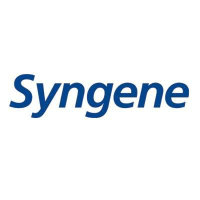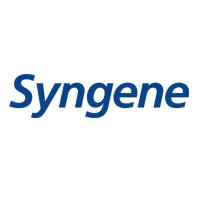
Syngene International Ltd
NSE:SYNGENE


| US |

|
Johnson & Johnson
NYSE:JNJ
|
Pharmaceuticals
|
| US |

|
Berkshire Hathaway Inc
NYSE:BRK.A
|
Financial Services
|
| US |

|
Bank of America Corp
NYSE:BAC
|
Banking
|
| US |

|
Mastercard Inc
NYSE:MA
|
Technology
|
| US |

|
UnitedHealth Group Inc
NYSE:UNH
|
Health Care
|
| US |

|
Exxon Mobil Corp
NYSE:XOM
|
Energy
|
| US |

|
Pfizer Inc
NYSE:PFE
|
Pharmaceuticals
|
| US |

|
Palantir Technologies Inc
NYSE:PLTR
|
Technology
|
| US |

|
Nike Inc
NYSE:NKE
|
Textiles, Apparel & Luxury Goods
|
| US |

|
Visa Inc
NYSE:V
|
Technology
|
| CN |

|
Alibaba Group Holding Ltd
NYSE:BABA
|
Retail
|
| US |

|
3M Co
NYSE:MMM
|
Industrial Conglomerates
|
| US |

|
JPMorgan Chase & Co
NYSE:JPM
|
Banking
|
| US |

|
Coca-Cola Co
NYSE:KO
|
Beverages
|
| US |

|
Walmart Inc
NYSE:WMT
|
Retail
|
| US |

|
Verizon Communications Inc
NYSE:VZ
|
Telecommunication
|
Utilize notes to systematically review your investment decisions. By reflecting on past outcomes, you can discern effective strategies and identify those that underperformed. This continuous feedback loop enables you to adapt and refine your approach, optimizing for future success.
Each note serves as a learning point, offering insights into your decision-making processes. Over time, you'll accumulate a personalized database of knowledge, enhancing your ability to make informed decisions quickly and effectively.
With a comprehensive record of your investment history at your fingertips, you can compare current opportunities against past experiences. This not only bolsters your confidence but also ensures that each decision is grounded in a well-documented rationale.
Do you really want to delete this note?
This action cannot be undone.

| 52 Week Range |
652
947.8
|
| Price Target |
|
We'll email you a reminder when the closing price reaches INR.
Choose the stock you wish to monitor with a price alert.

|
Johnson & Johnson
NYSE:JNJ
|
US |

|
Berkshire Hathaway Inc
NYSE:BRK.A
|
US |

|
Bank of America Corp
NYSE:BAC
|
US |

|
Mastercard Inc
NYSE:MA
|
US |

|
UnitedHealth Group Inc
NYSE:UNH
|
US |

|
Exxon Mobil Corp
NYSE:XOM
|
US |

|
Pfizer Inc
NYSE:PFE
|
US |

|
Palantir Technologies Inc
NYSE:PLTR
|
US |

|
Nike Inc
NYSE:NKE
|
US |

|
Visa Inc
NYSE:V
|
US |

|
Alibaba Group Holding Ltd
NYSE:BABA
|
CN |

|
3M Co
NYSE:MMM
|
US |

|
JPMorgan Chase & Co
NYSE:JPM
|
US |

|
Coca-Cola Co
NYSE:KO
|
US |

|
Walmart Inc
NYSE:WMT
|
US |

|
Verizon Communications Inc
NYSE:VZ
|
US |
This alert will be permanently deleted.
 Syngene International Ltd
Syngene International Ltd
Syngene International Ltd
Investor Relations
In the bustling landscape of the global pharmaceutical industry, Syngene International Ltd. stands out as a beacon of scientific innovation and strategic acumen. Founded in 1993, this Bangalore-based contract research and manufacturing organization (CRMO) has carved a niche by seamlessly blending cutting-edge research with commercial savvy. Syngene offers integrated services spanning the entire drug discovery and development continuum, catering to diverse sectors including pharmaceuticals, biotechnology, nutrition, animal health, consumer goods, and specialty chemicals. By providing end-to-end solutions, from target identification and discovery chemistry to pre-clinical and clinical development and up to commercial manufacturing, Syngene ensures that its clients can focus on their core competencies, thus accelerating their journey from lab to market.
Syngene's revenue model thrives on fostering long-term partnerships with global giants such as Bristol-Myers Squibb, Amgen, and Baxter, who rely on the company's deep scientific expertise and robust infrastructure. By offering bespoke solutions that address specific client needs, Syngene generates income through flexible, multi-year contracts and milestone payments at various stages of the drug development cycle. This approach not only ensures a steady revenue stream but also strengthens Syngene's reputation as a trusted partner in scientific innovation. With their state-of-the-art facilities and a team of world-class scientists, Syngene effectively marries scientific curiosity with business excellence, driving the future of health sciences and securing its position as a pivotal player in the CRMO field.

In the bustling landscape of the global pharmaceutical industry, Syngene International Ltd. stands out as a beacon of scientific innovation and strategic acumen. Founded in 1993, this Bangalore-based contract research and manufacturing organization (CRMO) has carved a niche by seamlessly blending cutting-edge research with commercial savvy. Syngene offers integrated services spanning the entire drug discovery and development continuum, catering to diverse sectors including pharmaceuticals, biotechnology, nutrition, animal health, consumer goods, and specialty chemicals. By providing end-to-end solutions, from target identification and discovery chemistry to pre-clinical and clinical development and up to commercial manufacturing, Syngene ensures that its clients can focus on their core competencies, thus accelerating their journey from lab to market.
Syngene's revenue model thrives on fostering long-term partnerships with global giants such as Bristol-Myers Squibb, Amgen, and Baxter, who rely on the company's deep scientific expertise and robust infrastructure. By offering bespoke solutions that address specific client needs, Syngene generates income through flexible, multi-year contracts and milestone payments at various stages of the drug development cycle. This approach not only ensures a steady revenue stream but also strengthens Syngene's reputation as a trusted partner in scientific innovation. With their state-of-the-art facilities and a team of world-class scientists, Syngene effectively marries scientific curiosity with business excellence, driving the future of health sciences and securing its position as a pivotal player in the CRMO field.





























 You don't have any saved screeners yet
You don't have any saved screeners yet
